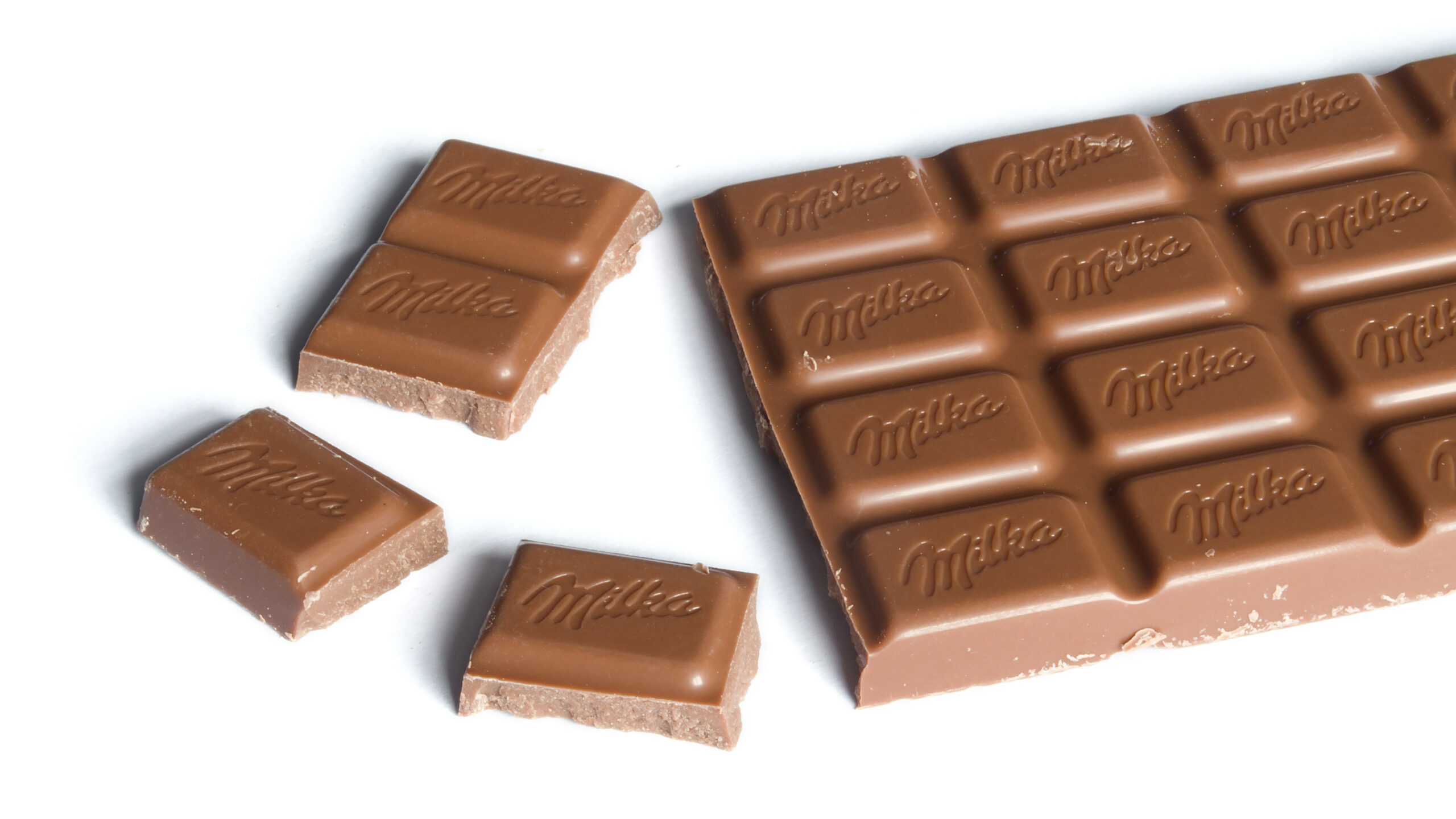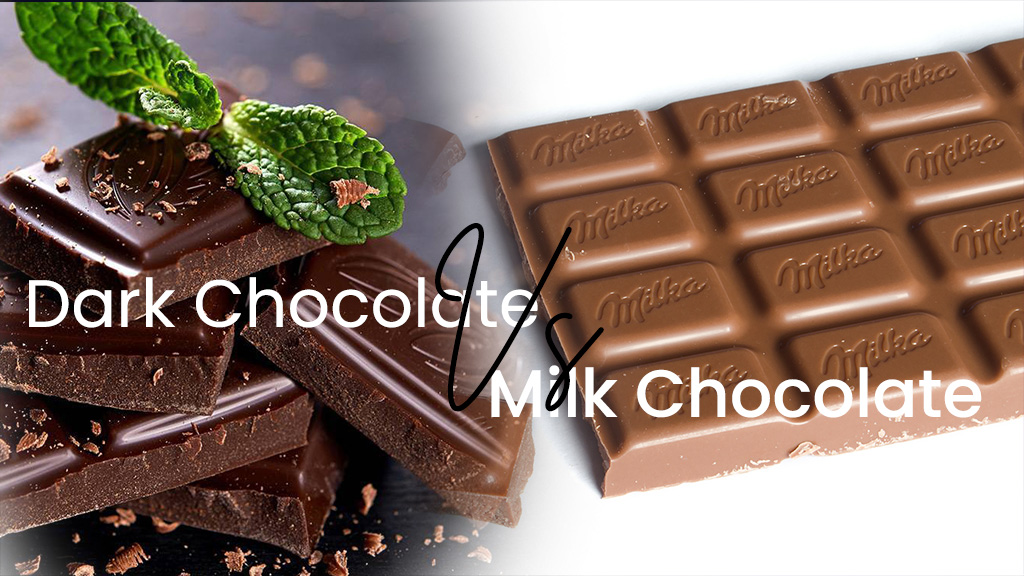Dark chocolate

Dark chocolate is a type of chocolate that contains a higher percentage of cocoa solids compared to other types like milk chocolate. The main ingredients in dark chocolate are cocoa solids, sugar, and sometimes a small amount of cocoa butter. The exact composition can vary between different brands and varieties.
The cocoa solids in dark chocolate are responsible for its rich, intense flavor. They also contribute to the dark color of the chocolate. The percentage of cocoa solids is usually indicated on the packaging, and it can range from around 50% to 90% or more. A higher percentage generally means a more intense chocolate flavor.
One of the key reasons dark chocolate is often considered a healthier option is its higher concentration of antioxidants. Antioxidants, such as flavonoids, may help protect cells from damage caused by free radicals and have been associated with various health benefits.
Dark chocolate is also known for containing minerals such as iron, magnesium, and copper. Additionally, it may have a lower sugar content compared to milk chocolate, making it a choice for those looking to limit their sugar intake.
Keep in mind that while dark chocolate can have health benefits, it’s still a calorie-dense food, so moderation is crucial. Enjoying small amounts of high-quality dark chocolate can be a delightful and relatively healthier indulgence.
Advantages of dark chocolate
Dark chocolate comes with several potential health advantages:
Rich in Antioxidants: Dark chocolate is loaded with antioxidants, such as flavonoids, which can help neutralize free radicals in the body, contributing to overall health and well-being.
Heart Health: Some studies suggest that the flavonoids in dark chocolate may have a positive impact on heart health by improving blood flow, reducing blood pressure, and potentially lowering the risk of heart disease.
Improved Brain Function: The presence of caffeine and other stimulants, along with antioxidants, may contribute to improved cognitive function. Dark chocolate might enhance memory and focus.
Mineral Content: Dark chocolate contains minerals like iron, magnesium, and copper. These minerals play essential roles in various bodily functions, including oxygen transport, muscle and nerve function, and the formation of red blood cells.
Mood Enhancement: Dark chocolate contains serotonin precursors, which may contribute to feelings of happiness and well-being. Additionally, the indulgence in a small amount of dark chocolate can trigger the release of endorphins.
Potential Diabetes Benefits: Some studies suggest that dark chocolate may help improve insulin sensitivity, which could be beneficial for those at risk of or managing diabetes.
Remember, while dark chocolate has its advantages, it’s important to consume it in moderation. Excessive intake can lead to an excess of calories and sugar, counteracting its potential benefits. Choosing high-quality dark chocolate with a higher cocoa content is generally recommended for maximum health advantages.
Disadvantages of Dark chocolate
While dark chocolate offers several health benefits, it’s important to be aware of potential disadvantages:
Calorie Density: Dark chocolate is calorie-dense, meaning it contains a significant amount of calories in a small serving. Consuming it in excess can contribute to weight gain.
Sugar Content: Although dark chocolate generally contains less sugar than milk chocolate, some varieties can still have a considerable amount. High sugar intake is associated with various health issues, including dental problems and an increased risk of chronic diseases.
Caffeine Content: Dark chocolate contains caffeine, which can be a disadvantage for individuals sensitive to caffeine or those aiming to reduce their overall caffeine intake. Excessive caffeine consumption can lead to issues like insomnia, jitteriness, and increased heart rate.
Allergies and Sensitivities: Some people may be allergic or sensitive to ingredients in dark chocolate, such as cocoa or milk. It’s essential to be aware of any potential allergies or intolerances.
Interactions with Medications: Dark chocolate can interact with certain medications. For example, it may interfere with medications that contain monoamine oxidase inhibitors (MAOIs) or anticoagulants. Individuals taking medications should consult their healthcare provider for guidance.|
Potential for Overconsumption: The rich and intense flavor of dark chocolate may lead to overconsumption. While it has health benefits in moderation, excessive intake can negate those advantages and contribute to an imbalance in one’s diet.
As with any food, moderation is key. Choosing high-quality dark chocolate with a higher cocoa content, and being mindful of portion sizes, can help individuals enjoy its benefits without experiencing the potential disadvantages.
Milk Chocolate

Milk chocolate is a type of chocolate that includes milk solids in addition to cocoa solids, sugar, and cocoa butter. The milk solids give it a smoother, creamier texture and a sweeter taste compared to dark chocolate. The exact composition of milk chocolate can vary, but it typically contains milk powder, liquid milk, or condensed milk.
The percentage of cocoa solids in milk chocolate is lower than that in dark chocolate, usually ranging from around 10% to 50%. The lower cocoa content contributes to the lighter color of milk chocolate.
Milk chocolate is often a popular choice for those who prefer a sweeter and milder chocolate flavor. It’s commonly used in various confections, such as chocolate bars, candies, and desserts. The addition of milk also gives it a smoother mouthfeel.
While milk chocolate is a delicious treat for many, it’s important to note that it generally contains more sugar and fat than dark chocolate. Some variations may include additional ingredients like emulsifiers, flavorings, and preservatives. As with any chocolate, moderation is key, especially for those mindful of their sugar intake or looking to enjoy a balance between indulgence and health.
Advantages of Milk chocolate
Milk chocolate also has its share of advantages:
Sweet Flavor Profile: Milk chocolate has a sweeter and creamier taste compared to dark chocolate, making it a popular choice for those with a sweet tooth.
Rich in Calcium: The milk content in milk chocolate provides a source of calcium, which is essential for maintaining strong bones and teeth.
Energy Boost: The sugar content in milk chocolate provides a quick source of energy, making it a convenient and enjoyable treat for a quick pick-me-up.
Versatility in Recipes: Milk chocolate is often used in a variety of desserts and confections, adding a delightful flavor to cakes, cookies, and other sweet treats.
Comfort Food: The comforting and familiar taste of milk chocolate can have psychological benefits, providing a sense of pleasure and satisfaction.
Broader Appeal: Milk chocolate is generally more palatable to a wider audience, including children and those who may find the intense flavor of dark chocolate less appealing.
While milk chocolate has these advantages, it’s important to consume it in moderation due to its higher sugar and fat content. As with any indulgence, balancing enjoyment with a well-rounded and healthy diet is key.
Disadvantages of milk chocolate
Milk chocolate, while delicious, also comes with some potential disadvantages:
High Sugar Content: Milk chocolate typically contains a significant amount of sugar, contributing to its sweet taste. Excessive sugar intake is associated with various health issues, including obesity, tooth decay, and an increased risk of chronic diseases.
Calorie Density: Like dark chocolate, milk chocolate is calorie-dense. Consuming it in large quantities can contribute to an excess of calories and may lead to weight gain.
Lower Cocoa Content: Compared to dark chocolate, milk chocolate has a lower percentage of cocoa solids. This means it may have fewer antioxidants and health-promoting compounds.
Less Intense Flavor: Some individuals may find the milder and sweeter flavor of milk chocolate less satisfying than the richer and more intense flavor of dark chocolate.
Potential for Overconsumption: The sweet and palatable nature of milk chocolate can sometimes lead to overconsumption, especially in situations where it is readily available.
Lactose Content: Individuals who are lactose intolerant may experience digestive discomfort due to the milk content in milk chocolate.
Interactions with Allergies: Like dark chocolate, milk chocolate may cause allergic reactions in individuals sensitive to ingredients such as cocoa, milk, or other components.
It’s important to enjoy milk chocolate in moderation and as part of a balanced diet. Choosing high-quality options with lower sugar content and being mindful of portion sizes can help mitigate some of the potential disadvantages. Individuals with specific dietary concerns or health conditions should consult with a healthcare professional for personalized advice.
Conclusion
In conclusion, both dark chocolate and milk chocolate have their unique characteristics and potential benefits, but they also come with certain considerations.
Dark Chocolate:
Advantages: Rich in antioxidants, potential heart health benefits, higher cocoa content, and minerals.
Disadvantages: Calorie-dense, may contain sugar, caffeine content, and potential for overconsumption.
Milk Chocolate:
Advantages: Sweeter taste, creamier texture, a source of calcium, energy boost, versatility in recipes, and broader appeal.
Disadvantages: High sugar content, calorie-dense, lower cocoa content, potential for overconsumption, and lactose content for those intolerant.
Ultimately, the choice between dark and milk chocolate depends on personal preference, health considerations, and dietary goals. Moderation is key for both, allowing individuals to enjoy the unique flavors and occasional indulgence without compromising overall well-being. Balancing these treats with a varied and nutritious diet ensures a more holistic approach to chocolate enjoyment.


